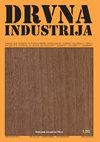Effect of Acetylation and Accelerated Weathering of Nigerian Grown Rubberwood (Hevea brasiliensis, Müll. Arg.) on Equilibrium Moisture Content and Colour Change
IF 0.8
4区 农林科学
Q4 MATERIALS SCIENCE, PAPER & WOOD
引用次数: 0
Abstract
This study was conducted to investigate the effect of acetylation on equilibrium moisture content (EMC) of Nigerian-grown rubberwood and its effect on colour change in exposure of rubberwood to surface degradation through accelerated weathering. The samples were modified to two levels of acetylation, which yielded weight percent gain (WPG) of 7 % and 10 % after 8hr (8-hr Acetyl) and 48hr of acetylation (48-hr Acetyl), respectively. Accelerated weathering of unmodified (Ref) and acetylated wood was done using QUV-Accelerated Weathering Tester for four weeks. The unmodified and acetylated samples (weathered and unweathered) were oven-dried and conditioned in climate rooms at different relative humidity of 50 %, 65 % and 95 %, with samples being moved to each room after 14 days. Results showed that acetylation led to a significant decrease in equilibrium moisture content of rubberwood. After weathering, there was a decrease in EMC of rubberwood due to removal of hemicelluloses alongside the degraded lignin, and a slight increase in EMC of the acetylated wood. In terms of colour change, photo-bleaching of the acetylated samples was higher (10.46 for 48-hr Acetyl) after four weeks of weathering compared to the unmodified samples (6.43). Hence, the outcome of this study has shown that, although acetylation is effective in minimizing moisture ingress into wood, it resulted in photo-bleaching of the weathered samples. Additional surface coating is recommended to serve as a protective layer, preventing partial washing out of the acetyl groups, minimize photo-bleaching during weathering and prolong the aesthetic value of the wood especially in outdoor applications such as wall cladding and façade.尼日利亚橡胶木乙酰化和加速风化的影响论平衡水分含量和颜色变化
本研究探讨了乙酰化对尼日利亚橡胶木平衡含水率(EMC)的影响及其对橡胶木表面加速风化降解过程中颜色变化的影响。将样品修饰为两种乙酰化水平,分别在8小时(乙酰化8小时)和48小时(乙酰化48小时)后获得7%和10%的体重增加(WPG)。采用quv加速风化试验机对未改性(Ref)和乙酰化木材进行了4周的加速风化试验。未改性和乙酰化的样品(风化和未风化)在相对湿度为50%,65%和95%的气候室内进行烘箱干燥和调节,14天后将样品移至每个房间。结果表明,乙酰化处理显著降低了橡胶木材的平衡含水率。风化后,随着木质素的降解,半纤维素的去除使橡胶木的EMC降低,而乙酰化木材的EMC略有增加。在颜色变化方面,经过四周的风化后,乙酰化样品的光漂白(48小时乙酰化)比未修饰的样品(6.43)更高(10.46)。因此,本研究的结果表明,尽管乙酰化可以有效地减少水分进入木材,但它会导致风化样品的光漂白。建议额外的表面涂层作为保护层,防止乙酰基的部分洗涤,最大限度地减少风化过程中的光漂白,延长木材的美学价值,特别是在室外应用中,如墙包层和外墙。
本文章由计算机程序翻译,如有差异,请以英文原文为准。
求助全文
约1分钟内获得全文
求助全文
来源期刊

Drvna Industrija
MATERIALS SCIENCE, PAPER & WOOD-
CiteScore
1.80
自引率
9.10%
发文量
32
审稿时长
>12 weeks
期刊介绍:
"Drvna industrija" ("Wood Industry") journal publishes original scientific and review papers, short notes, professional papers, conference papers, reports, professional information, bibliographical and survey articles and general notes relating to the forestry exploitation, biology, chemistry, physics and technology of wood, pulp and paper and wood components, including production, management and marketing aspects in the woodworking industry.
 求助内容:
求助内容: 应助结果提醒方式:
应助结果提醒方式:


